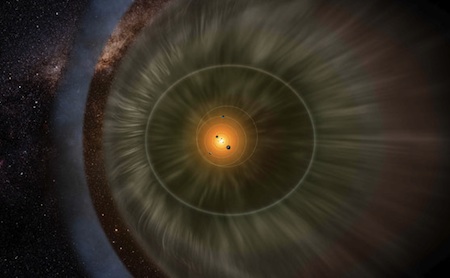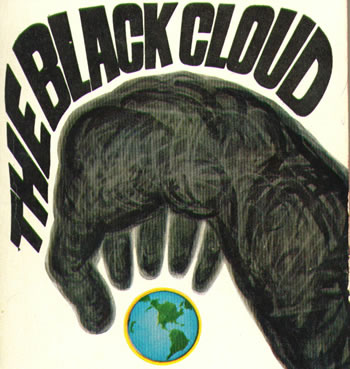Science Fiction
Dictionary
A B C D E F G H I J K L M N O P Q R S T U V W X Y Z
We Live In A Space Cloud

According to the latest data from IBEX (Interstellar Boundary Explorer, or IBEX), we are slowly traveling through a thin cloud of interstellar material, but are close to the boundaries. IBEX’s measurements of interstellar hydrogen, oxygen, and neon are the first–ever detections of these atoms by any spacecraft.

(An artist’s rendition of a portion of our heliosphere
with the solar wind streaming out past the planets and forming a boundary as it interacts with the material between the stars.)
Our entire heliosphere, which contains our Sun, the planets, and everything else in our Solar System, is moving through the interstellar medium. Because of this motion, a sort–of "breeze" of interstellar material moves toward our heliosphere’s boundary. The interstellar neutral atoms are just that – "neutral" – meaning they do not interact with magnetic fields. ISNs [interstellar neutral atoms] move through the boundary of our heliosphere without the boundary affecting them...There appears to be a network of gas and dust clouds in our local galactic vicinity. While very dilute and thin, the general positions of these clouds can still be measured. As our heliosphere (and everything in it) orbits the center of our galaxy, we pass into and out of these clouds at various times...
Based on Ulysses results, previous science teams had concluded that our heliosphere was located in between two of the nearby clouds, the "Local Cloud" and the "G-Cloud" and transitioning into a new region of space. However, while the boundary of the Local Cloud is very close, IBEX results show the heliosphere remains fully in the Local Cloud, at least for the moment. "Sometime in the next hundred to few thousand years, the blink of an eye on the timescales of the galaxy, our heliosphere should leave the local interstellar cloud and encounter a much different galactic environment," Dave McComas [IBEX Principal Investigator] says.
Astronomer Fred Hoyle wrote about interstellar clouds encompassing the Earth in his 1957 novel Black Cloud. In the story, an astronomy grad student named Knut Jensen was going about the rather prosaic work of looking for supernovae. In the 1950's, the best way to do this was to take a picture of a patch of sky, and then take another picture a month or so later. The two pictures (or photographic plates) were placed side-by-side in a device called a "blink comparator" (called a 'blinker' in the story). By glancing first at one and then the other, any stars that suddenly become brighter are easily seen.
In a rich star field was a large, almost exactly circular, dark patch.
Further study demonstrated that this cloud was moving directly toward the sun, and that it appeared to demonstrate intelligence. Scientists puzzled over how an intelligent entity could control an enormous gaseous nebula, and decided that it must be done through the manipulation of magnetic fields within the cloud of gas:
"I imagine that the beast orders the material of the cloud magnetically, that by means of magnetic fields he can move materials wherever he wants inside the cloud."
(Read more about magnetic control of nebulae)

(Earth menaced by a power beyond the planets and older than time!)
Similar space clouds have menaced Earth in novels like "Exit Earth" by Martin Caidin and in the short story "Transience" by Arthur C. Clarke.
Update 10-Apr-2022: The earliest reference to this idea that I know about is the poison space cloud in The Poison Belt, a 1913 novella by Arthur Conan Doyle:
"You will conceive a bunch of grapes," said he, "which are covered by some infinitesimal but noxious bacillus. The gardener passes it through a disinfecting medium. It may be that he desires his grapes to be cleaner. It may be that he needs space to breed some fresh bacillus less noxious than the last. He dips it into the poison and they are gone. Our Gardener is, in my opinion, about to dip the solar system, and the human bacillus will in an instant be sterilized out of existence."
End update.
Via the IBEX website.
Scroll down for more stories in the same category. (Story submitted 2/4/2012)
Follow this kind of news @Technovelgy.| Email | RSS | Blog It | Stumble | del.icio.us | Digg | Reddit |
Would
you like to contribute a story tip?
It's easy:
Get the URL of the story, and the related sf author, and add
it here.
Comment/Join discussion ( 2 )
Related News Stories - (" Space Tech ")
Will Space Stations Have Large Interior Spaces Again?
'They filed clumsily into the battleroom, like children in a swimming pool for the first time, clinging to the handholds along the side.' - Orson Scott Card, 1985.
Reflect Orbital Offers 'Sunlight on Demand' And Light Pollution
'I don't have to tell you about the seven two-mile-diameter orbital mirrors...'
Chrysalis Generation Ship to Alpha Centauri
'This was their world, their planet —
this swift-traveling, yet seemingly moveless vessel.' - Nat Schachner, 1934
The First Space Warship For Space Force
'Each of the electrical ships carried about twenty men...' - Garrett P. Serviss, 1898.
Technovelgy (that's tech-novel-gee!) is devoted to the creative science inventions and ideas of sf authors. Look for the Invention Category that interests you, the Glossary, the Invention Timeline, or see what's New.
Science Fiction
Timeline
1600-1899
1900-1939
1940's 1950's
1960's 1970's
1980's 1990's
2000's 2010's
Current News
Natural Gait With Prosthetic Connected To Nervous System
'The leg was to function, in a way, as a servo-mechanism operated by Larry’s brain...'
Woman Marries Computer, Vonnegut's Dream Comes True
'Men are made of protoplasm... Lasts forever.'
Spidery 'Walk Me' Toyota Autonomous Wheel Chair Like Star Wars
Walk along with the emperor.
Dancing Robots Taught Dance Moves
'A clockwork figure would be the thing for you...'
Proof Of Robothood - Not A Person
'Who are you people? - Show 'em.'
Indonesian Clans Battle
'The observation vehicle was of that peculiar variety used in conveying a large number of people across rough terrain.'
The 'Last Mile' In China Crowded With Delivery Robots
Yes, it's a delivery robot. On wheels.
Tornyol Microdrone Kills Mosquitoes
'The real border was defended by... a swarm of quasi-independent aerostats.'
PLATO Spacecraft, Hunter Of Habitable Planets, Now Ready
'I ... set my automatic astronomical instruments to searching for a habitable planet.'
Factory Humanoid Robots Built By Humanoid Robots
'...haven't you a section of the factory where only robot labor is employed?'
iPhone Air Fulfils Jobs' Promise From 2007 - A Giant Screen!
'... oblongs were all over the floor and surfaces.'
ChatGPT Now Participates in Group Chats
'...the city was their laboratory in human psychology.'
iPhone Pocket All Sold Out!
'A long, strong, slender net...'
Did The Yautja Have These First?
What a marvel of ingenuity the little device was!
Jetson ONE Air Races Begin, Can Air Polo Be Far Behind?
'If you're one of those rarities who haven't attended a rocket-polo "carnage", let me tell you it's a colorful affair.'
Will Space Stations Have Large Interior Spaces Again?
'They filed clumsily into the battleroom, like children in a swimming pool for the first time, clinging to the handholds along the side.'
